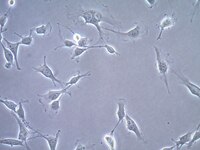SCC447 Sigma-AldrichOSUMMER.3 Mouse NRAS-Mutant Melanoma Cell Line
Recommended Products
概述
| Replacement Information |
|---|
| References |
|---|
| Product Information | |
|---|---|
| Quality Level | MQ100 |
| Biological Information | |
|---|---|
| Cell Line Type |
|
| Physicochemical Information |
|---|
| Dimensions |
|---|
| Materials Information |
|---|
| Toxicological Information |
|---|
| Safety Information according to GHS |
|---|
| Safety Information |
|---|
| Product Usage Statements | |
|---|---|
| Quality Assurance | Each vial contains ≥1X10⁶ viable cells. Cells are tested negative for infectious diseases by a Mouse Essential CLEAR Panel by Charles River Animal Diagnostic Services. Cells are verified to be of mouse origin and negative for inter-species contamination from rat, human, Chinese hamster, Golden Syrian hamster, and Non-human Primate (NHP) as assessed by a Contamination Clear panel by Charles River Animal Diagnostic Services Cells are negative for mycoplasma contamination. |
| Usage Statement |
|
| Packaging Information | |
|---|---|
| Material Size | ≥1X10⁶ cells/vial |
| Transport Information |
|---|
| Supplemental Information |
|---|
| Specifications |
|---|
| Global Trade Item Number | |
|---|---|
| 产品目录编号 | GTIN |
| SCC447 | 04065267036496 |
Documentation
OSUMMER.3 Mouse NRAS-Mutant Melanoma Cell Line MSDS
| 职位 |
|---|
数据表
| 标题 |
|---|
| Data Sheet-SCC447 |
















